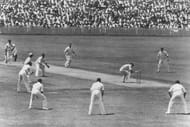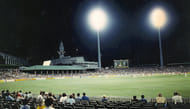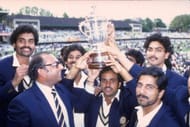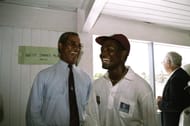As you will be aware, the first ever Test match took place between Australia and England at the Melbourne Cricket Ground (MCG) in 1877. Ever since then, the game of cricket has never stood still to its credit. Each passing decade has seen various landmarks being achieved and numerous changes to the game taking effect, all of which have largely been for the betterment of the game - whether it was “Bodyline” prompting a gradual ban on intimidatory bowling back in the 1930s or the surge in popularity of the T20 format as recently as in the 2000s.Here are some of the most iconic and momentous cricket events to have taken place in each decade:(Note: The below list of events in each decade is in chronological order)
#1 1930s to 1960s - \"Bodyline\"

Bodyline (1932)
The backdrop to the hugely controversial Ashes series of 1932-33, famously known as “Bodyline”, is provided by the fact that Don Bradman amassed a staggering 974 runs at a batting average of 139.14 in the previous Ashes series in England in 1930. So by the time the series in Australia came along, Bradman was at the absolute peak of his powers, and England captain Douglas Jardine felt they had no chance of regaining the Ashes unless they came up with an unorthodox tactic to counter not just Bradman but the Australian side as a whole.
As a consequence, Jardine instructed his bowlers to bowl at leg-stump and aim at the body of the Australian batsmen with a cordon of close-in fielders being placed on the leg side to grab any chance that comes their way.
While the plan had the desired effect with England winning the series 4-1 and Bradman averaging a relatively meagre 56.57, it led to the relations between the two sides deteriorating beyond repair. Australian captain Bill Woodful, referring to England’s unethical tactics, famously remarked, “There are two teams out there, one is playing cricket. The other is making no attempt to do so”.
Australia - The Invincibles (1948)
The Australian team which toured England in 1948 under the captaincy of Don Bradman came to be known as The Invincibles after becoming the first side to go through an entire tour of England without losing a single game. Till this date, it remains the only one to do so and is rightly regarded as one of the best cricket teams ever.
Containing greats like Keith Miller, Arthur Morris, Neil Harvey, Ray Lindwall and Bradman himself, Australia won the 5-match Test series 4-0 in addition to winning 23 and drawing 8 of the 31 first-class fixtures they played on the tour.
The tour also held special significance as it was Bradman’s final ever Test series, retiring with a phenomenal 6,996 runs at an aggregate of 99.94 from his 52 Tests.
Jim Laker’s 10-wicket haul
Jim Laker achieved a unique feat in Test cricket when he became the first bowler in Test cricket to take all 10 wickets in the 2nd innings of an Ashes Test against Australia at Old Trafford in 1956. Having taken 9 for 37 in the 1st innings as well, Laker finished with outstanding match figures of 19 for 90 to lead England to a colossal innings and 170-run win.
Since then, India’s Anil Kumble is the only bowler to mirror Laker’s feat, courtesy of his match-winning 10/74 against Pakistan at Delhi in 1999.
First ever tied Test (1960)
The 1960 Test match between Australia and West Indies at The Gabba, Brisbane, is widely considered among the greatest Tests ever played and rightly so, as the match was one of only two tied Tests in the format’s 138-year-old history. The other one came between India and Australia in Chennai in 1986, giving you a fair idea of how rare such an outcome is in Test cricket.
West Indies won the toss and posted 453 on the board after choosing to bat first, with Garry Sobers scoring a magnificent 132. In reply, Australia bettered West Indies’ effort as they amassed an imposing total of 505, thereby securing a lead of 52. Australia then managed to bowl out the West Indians for just 284, with left-armer Alan Davidson taking 6/87.
Davidson had to come to the rescue of the hosts with the bat too, as they found themselves precariously placed at 6/92 in pursuit of 233 for victory when Richie Benaud joined the left-armer at the crease. They stitched together an outstanding 134-run partnership to take Australia to 226/6 before a late-order collapse resulted in Test cricket’s first ever tie.
#2 1970s - Rise of ODI cricket

Boycott of South Africa (1970)
South Africa was indefinitely banned from international cricket due to the policy of apartheid prevailing in the country at the time. The ban was precipitated by the inclusion of the Cape Coloured South African Basil D’Oliveira in the England squad for the tour of South Africa, which wasn’t acceptable to South African officials at the time.
Their resistance to D’Oliveira’s inclusion led to worldwide protests against the South African regime and the eventual cricketing boycott of South Africa. While the ban did a lot of good to both South African sport and society in the long run, forcing them to abolish the oppressive apartheid era, the fact that cricketers of the calibre of Barry Richards and Graeme Pollock were limited to just a handful of appearances was a real pity.
Birth of ODI cricket (1971)
Interestingly, the circumstances in which the first ever ODI was played between Australia and England at the MCG on January 5, 1971, were completely coincidental. The first 3 days of the Ashes Test had been washed out due to rain, as a result of which the authorities decided to play a one-off one-day game consisting of 40-overs per side in order to entertain the crowd that had gathered.
Since then, of course, the one-day game has become an absolutely integral and popular part of the cricketing calendar, with as many as 10 ODI World Cups having been held.
Inaugural World Cup (1975)
Talking about World Cups, the first ever World Cup was held in England in the year 1975, with the tournament culminating at the iconic Lord’s Cricket Ground. The players themselves, by all accounts, weren’t too sure of whether such a concept would work before the tournament started.
But that certainly changed once that World Cup came to its conclusion, courtesy largely of a humdinger of a final between Australia and West Indies, thereby assuring the stakeholders of the game that the World Cup was here to stay.
World Series Cricket (1977)
World Series Cricket, which was played between 1977 and 1979, was the brainchild of Australian business tycoon Kerry Packer, who held a desire to acquire the exclusive broadcasting rights of Australian cricket. The rights were held by the Australian Broadcasting Commission (ABC) at the time, and the Australian Cricket Board (ACB) was unwilling hand over the rights to Packer’s Channel Nine. Well aware of the fact that the players were not being paid well enough to make a living from the sport, Packer took advantage and secretly signed some of the best players in the world.
World Series Cricket saw some popular inventions which subsequently became an integral part of the game – day-night cricket and coloured clothing just being a few.
#3 1980s - India cause big upset with World Cup win

West Indies’ domination
West Indies started gathering an array of domineering players of the ilk of Vivian Richards, Michael Holding and Malcolm Marshall, who were going to serve them well for a long period of time, during the mid to late 1970s. But it would be fair to say that it was in the 1980s that we saw all these supremely talented cricketers play at their absolute peak, illustrated by the fact that the men from the Caribbean didn’t lose a single Test series anywhere in the world throughout the ‘80s.
They not only found a way to win irrespective of the conditions on offer but also managed to play an attacking brand of cricket, making them extremely popular among cricket lovers around the world in the process.
Underarm bowling banned (1981)
With New Zealand needing six to tie against neighbours Australia in the final of the 1981 Benson & Hedges Cup at Melbourne Cricket Ground (MCG), Australian captain Greg Chappell instructed bowler Trevor Chappell, his younger brother, to deliver the ball along the ground underarm in order to prevent any chance of the Kiwis tying the match.
While Australia succeeded in winning the game, the incident sparked a furious reaction and the hosts were booed off the field by the MCG crowd.
Channel 9 commentator Richie Benaud deplored the incident and said it was “one of the worst things I have ever seen done on a cricket field”.
At the time of the incident, underarm bowling was legitimate as per the laws of the game but it was banned by the ICC as being contrary to the “spirit of the game” soon after.
Botham’s Ashes (1981)
The 1981 Ashes series between England and Australia is popularly known as Botham’s Ashes, and it’s not hard to understand why when you consider he finished up both as England leading run-scorer and wicket-taker, with 399 runs and 34 wickets from 6 Tests.
The 3rd Test at Headingley, Leeds, in particular, saw Botham at his domineering best as he helped pull off a miraculous 19-run victory courtesy of a spectacular 149* when England seemed down and out, in addition to taking 6/95 with the ball in the 1st innings.
India’s World Cup victory (1983)
India had headed into the 1983 World Cup having won just one of the seven matches they played during the previous two World Cups, in 1975 and 1979. Naturally then, the team were expected to be just mere passengers in the World Cup, with a respectable exit being the maximum that the team could’ve hoped for.
However, things panned out completely differently, much to the Indian fans’ delight, as India progressed to the semi-finals with the added distinction of being the only team to defeat the West Indies in the group stages. They then went on to beat England in the semi-finals before pulling off one of the biggest wins in Indian history by beating the mighty West Indians in the final.
#4 1990s - Brian Lara breaks 36-year-old world record

Brian Lara breaks the world record for highest Test score (1994)
Brian Lara made his foray into international cricket not only with the reputation of being a domineering and classy batsman but also as someone with a penchant for big scores. His 375 against England at St. John’s, Antigua, in 1994 certainly showed all those qualities in abundance as he broke another West Indian Sir Garry Sobers’ 36-year-old record for the highest ever score in Test cricket.
Australia end West Indies domination (1995)
Australia ended West Indies’ 15-year long domination on world cricket in 1995 when they beat the men from the Caribbean 2-1 in their own backyard to claim the Frank Worrell trophy. Steve Waugh, with 429 runs at an average of over 100 in the series, was the star with the bat while Glenn McGrath led the Australian bowling attack admirably with 17 wickets to his name.
The series not only marked the end of the West Indies’ domination but also signalled the start of an extremely special era for Australian cricket.
Muttiah Muralitharan’s no-ball controversy (1995)
One of the biggest cricket controversies of the 1990s erupted in 1995 when Australian umpire Darrell Hair no-balled off-spinner Muttiah Muralitharan for chucking in the Boxing Day Test match between Australia and Sri Lanka. Hair called him for throwing seven times in three overs, prompting Ranatunga to take the entire Sri Lankan team off the field as a sign of protest.
Sri Lanka’s World Cup victory (1996)
Sri Lanka firmly established themselves as a force to be reckoned with in international cricket following their famous win in the 1996 World Cup in the subcontinent. They reinvented the way ODI cricket was played to a certain extent by having two aggressive openers, Sanath Jayasuriya and Romesh Kaluwitharana, at the top of the order who took full advantage of the fielding restrictions in the first 15 overs. Backed by an astute captain in Arjuna Ranatunga, the Lankans thoroughly deserved to win the tournament as they beat no less than favourites India and Australia by emphatic margins in the semi-finals and finals, respectively.
#5 2000s - The menace of corruption

Match-fixing saga
The match-fixing saga of 2000 which saw a number of prominent cricketers from different nationalities being banned from playing the game for life took the entire cricketing world by shock at the time and is an incident which significantly affected the integrity of the game. The likes of Hansie Cronje, Mohammad Azharuddin and Ajay Jadeja were all banned from the game, and while there was no concrete evidence to prove the latter two’s involvement, it haunted Indian cricket for a long while.
Shane Warne’s one-year international ban (2003)
Shane Warne’s one-year ban from international cricket just a day before Australia began their 2003 World Cup campaign after being found guilty of consuming a banned drug came as a big jolt to Australian cricket. One of the best spin bowlers to have graced the game, Warne had been an integral part of Australia’s World Cup plans, but they had to do without him with very little time to prepare for such an eventuality. They managed superbly, however, as they won the tournament without losing even a single game.
Indian Premier League (2008)
The lucrative Indian Premier League (IPL) was inaugurated in 2008 under the supervision of Lalit Modi. Although the league has seen its fair share of controversies over the years, the tournament, by itself, has only gone from strength to strength. Apart from the fact that the best T20 players from around the world come to participate in the league every April-May, it also serves as a breeding ground for the young Indian cricketers seeking exposure of top-level cricket.
Pakistan spot-fixing (2010)
In what was one of the grimmest incidents in cricket history, Salman Butt, Mohammad Asif and Mohammad Amir, were banned from international cricket for 10, 7 and 5 years, respectively, after being found guilty of spot-fixing against England at Lord’s back in 2010. Asif and Amir purposely bowled no-balls with Butt’s consent, who was acting under instructions of a UK-based bookmaker.
The three players were convicted in a UK court a year later and handed out jail sentences in what set out a healthy precedent for future offenders.
Follow IPL Auction 2025 Live Updates, News & Biddings at Sportskeeda. Get the fastest updates on Mega-Auction and cricket news
